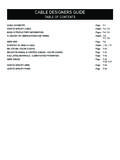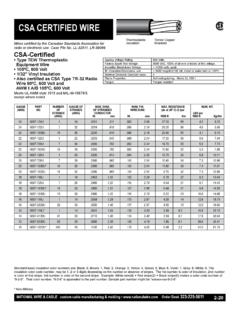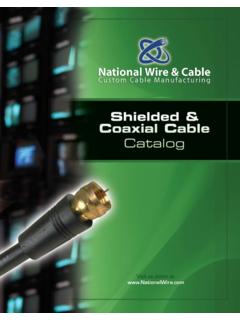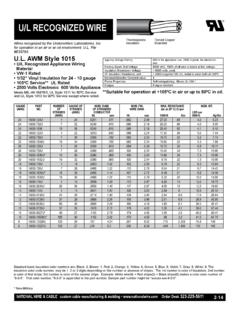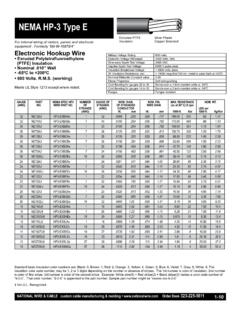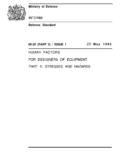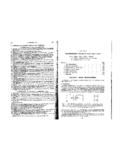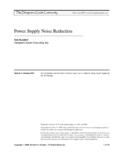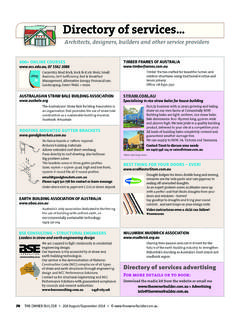Transcription of CABLE DESIGNERS GUIDE - National Wire
1 CABLE DESIGNERS GUIDE TABLE OF CONTENTSCABLE GEOMETRY Page 7-1 HOW TO SPECIFY CABLE Pages 7-2, 7-3 BASIC INTRODUCTORY INFORMATION Pages 7-4, 7-5 GLOSSARY OF ABBREVIATIONS AND TERMS Pages 7-6, 7-7, 7-8 WIRE AWG Page 7-9 SYNOPSIS OF WIRE & CABLE Pages 7-10, 7-11 MIL-STD-681 COLOR CODING Page 7-12 MINIATURE SIGNAL & CONTROL CABLES - COLOR CODING Page 7-13 INSULATING MATERIALS - COMPARATIVE PROPERTIES Page 7-14 WIRE TABLES Page 7-15, 7-16, 7-17 HOW TO SPECIFY WIRE Page 7-18 HOW TO SPECIFY PAIRS Page 7-19 CABLE DESIGNERS GUIDECABLE GEOMETRYD esign Geometry of Multi-Conductor Cables To those outside of the industry, the geometric design principles used in CABLE -making may not be apparent.
2 To assist the customer in compre-hensively discussing his needs with our factory engineering staff, we offer a brief GUIDE to the major design options and tradeoffs available. A DESIGNERS check list for specifying CABLE is offered elsewhere in this section. Not all are aware that for a given number of wires, several different geometry s may be used to form the wires into a helical CABLE bundle. Any of them may be justified, depending on cost, intended use and performance, or limitations of the manufacturers equipment. National Wire & CABLE Corp. has perhaps the widest and most versatile selection of modern CABLE -making equipment in the custom CABLE industry.
3 We welcome your knotty design problems. Our 40 years of experience in wire & CABLE field are at your Layup Geometry OptionsA. Layer Upon layer When all conductors have equal diameters they can be cabled in simple layers around a suitable core or central wire. Theoretically, every layer will contain 6 more wires than the preceding inner layer. This can be shown with a few round disks or coins. In practice this is not always true. Tolerances of insulation diameters enter the picture. Further, the conduc-tors spiral in a helical path when formed into CABLE , and thus occupy an elliptically-shaped area around the circumference of the core.
4 Typically, the eccentricity of the ellipse is about 5%. Thus about 19 conductors may fit, where 20 should if they were assumed to occupy a circular Subcabeling For some constructions small groups of wires are helically cabled into subcables, which are then helically cabled to form the finished bundle. They may take these forms due to the end use requirements, ( : where the design calls for twisted pairs, trios, etc.) or may do so mainly for the conve-nience of the lay-up of the required number of wires in an available site with-in the CABLE cross-section. Advantages of this method are improved flexibil-ity of the CABLE , possible convenience in the intended end-use for the CABLE and the wide selection of geometry s it offers the designer .
5 Disadvantages compared to the layer-on layer method are usually increased diameter and cost. Where there are hundreds of conductors in a CABLE , this method is often used to permit cabling on relatively small cabling Filling Interstices When a CABLE contains a wide mixture of wire diameters, the larger wire sizes or subcables may be CABLE -formed so as to deliberately leave interstices large enough for the smaller wires to lie within tangent to two adjacent large wires, but not in contact with the inner layer or Use of Fillers Where a layer requires more wires than are available to properly fill all positions in that layer.
6 Round fillers are used to occupy the otherwise vacant sites. Their use ensures a round shape and provides adequate support for the outer layers of the construction. These may be spare wires, or of plastic rod, jute, or twisted yarns or tapes. They are often used as a core member, and may be deliberately designed into a layer to permit circumferential com-pression in a layer during flexing of the Flexibility When a helically cabled bundle is flexed, each of the wires in a layer tend to slide along their helical path slightly with respect to the wires ad-jacent. If the wires are in firm contact around the entire layer, the friction between them inhibits the desired sliding action, and additional stiffness is imparted to the CABLE .
7 Interlayer friction can also contribute to CABLE stiff-ness. In general, any stored radial forces which contribute to the friction should be avoided by proper design and manufacturing techniques. These forces may be from unduly snug jackets, braids, wraps, or Flexibility Design Assistance Due to the many variable factors which influence CABLE designs, we strongly recommend that the customer consult with our technical staff to ensure proper choice of dimensions and tolerances when he generates his own specification. For design reference, a few of the common geometry s for subcabled and intersticed constructions are shown.
8 The diameter of the large mem-bers is taken to be one unit of diameter. The size of the other members are shown as some decimal which relates their size to that of the large member. For layer-on-layer constructions, the table shows the factor by which the wire diameter can be multiplied to obtain the cabled bundle OF HELICALLY CABLED BUNDLES*TO FIND THE CABLED DIAMETER OF A LAYER-ON-LAYER CONSTRUCTION, MULTIPLY THE DIAMETER OF A WIRE BY THE FACTOR SHOWN.**No. ofConductors Diameter Factor No. ofConductors Diameter Factor Number of Conductors Diameter Factor Number of Conductors Diameter Factor- - 13-14 34-37 64-67 15-16 38-39 68-73 17-19 40-42 74 20 43-47 75-78 21-22 48 79-83 23-26 49-51 84-89 27 52-55 90-93 28-30 56-60 94-98 31-33 61-63 99-105 * All conductors are the same diameter** (these factors are typical for standard helical cabling prectices.)
9 Slight variations may occur on certain combinations) QUAD QUINT6 AROUND 1 POSSIBLE CABLE CONFIGURATIONS & RELATIVE DIMENSIONS7-1 National WIRE & CABLE custom CABLE manufacturing & molding Order Desk 323-225-56117-2 National WIRE & CABLE custom CABLE manufacturing & molding Order Desk 323-225-5611 CABLE DESIGNERS GUIDEHOW TO SPECIFY CABLEIn the absence of your own CABLE specification, the following checklist will assist you to completely specify the CABLE you want: A. Number and gauge of Specification type of wire (military or commercial).C. Coding of conductors or subcables, striping or numbering, if Tape barrier, used as first mechanical protective layer.
10 Can be of Vinyl, Mylar, Tedlar, Polyethylene, or paper-fiberglass Type of electrical shielding or mechanical % coverage required for electrical shieldingG. Type of outer jacket Color of outer jacket, sheath Wall thickness of outer Necessary physical or environmental requirements, see Minimum and maximum overall diameter. Physical Requirements1. Length, tolerance; Diameter, Overall tensile strength, if Weight Minimum bend radius. Environmental Requirements 1. Minimum and maximum operating Physical abuse: terrain, degree of movement of flexing, possible sudden impacts or pressures, Surrounding medium: water, oil, sunlight, ice, fuels, air, etc.
